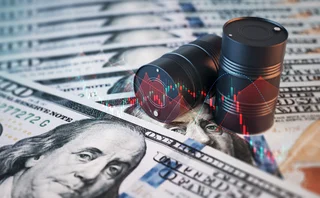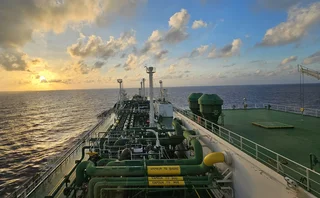
Energy Risk Commodity Rankings: banks and brokers battle extreme volatility
Winners of the 2022 Commodity Rankings needed new approaches to manage extreme price swings
Click here to view the full tables
Uncertainty and volatility characterised most commodities markets during 2021 as firms grappled with fallout from the global pandemic and some severe weather events, including Storm Uri which hit Texas in February 2021. The last quarter of the year saw steep backwardation and extreme price spikes across the complex. However, far more disruption was to come at the start of 2022 as geopolitical risk ramped up ahead of Russia’s March invasion of Ukraine.
The spot price of Brent crude, which averaged $54.77 a barrel (/bbl) in January 2021, reached $83.54/bbl in October, before closing out the year at $74.17/bbl. By the end of January 2022, when the Commodity Rankings closed, Brent had jumped to $86.51/bbl.
Gas prices saw far greater swings. Futures prices on the Dutch TTF gas hub, which opened the year at €17.89 ($19.73) per megawatt hour (/MWh), rose more than 700% to hit €146.93/MWh by December 20, 2021. Throughout the period that the Commodity Rankings survey was live – between November and January – prices traded between a high of €146.93/MWh and a low of €77.01/MWh – a 47% price swing in just a few days.
The metals markets also saw a run-up in prices over 2021 as economies opened up again after lockdowns. Iron ore was the main exception with prices falling back as China’s slowing growth curbed demand. LME tin prices, on the other hand, rose by 88% over 2021, from $21,034 per tonne to $39,635 per tonne.
Volatility on this scale poses enormous challenges to all companies operating in the markets, but particularly to small and medium-sized entities. While hedging becomes increasingly important, it is also more challenging. Firms found some of the hedging strategies that had worked for them in the past were not offering the right amount of protection. In fact, some even created higher levels of risk. The volatility led to a huge increase in margin calls, potentially putting firms in danger of defaulting on their positions.
As the share of renewables ramps up, it is becoming harder for wholesale market participants to forecast demand and resource availability while managing their positions and mitigating market risk
Firms turned to banks, brokers and research providers to help them navigate the new landscape. They needed innovative hedging solutions, as well as dynamic credit, funding and liquidity services.
In addition to Covid-19 and rising geopolitical risk, climate risk and the spread of renewables added further challenges to operating in the market, particularly the power markets. As the share of renewables ramps up, it’s harder for wholesale market participants to forecast both demand and where supply will come from, while managing their positions and mitigating market risk.
The Commodity Rankings give an indication of which firms are likely to have dealt with these issues the best, as market participants vote for their preferred brokers and dealers across the commodities complex. The league tables were dominated again this year by Axpo Group and Engie Global Markets, with the former taking the top spot in oil and energy overall, and the latter scooping first place in power. UBS was number one on the precious metals leaderboard, with TD Bank coming second in precious and first in base metals. BP topped the natural gas tables.
On the brokerage side, SCB Group bagged first place in energy overall, reflecting the importance of environmental trading today, with Tullet Prebon climbing up the ranks from last year to take second place. Blue Commodities, a crude oil and agricultural broker – and a relatively new entrant to the Commodity Rankings – came in third place in the overall energy category.
Elsewhere in the survey, Societe Generale picked up first place for cross-commodity research, while Engie’s Egma platform won the OTC trading platform category.
How the poll was conducted
The Energy Risk Commodity Rankings survey was live between November 24, 2021 and January 25, 2022 and received valid responses from 1,040 individuals. The survey asked respondents to vote for their top three dealers and brokers in any markets in which they had been active over the previous year. The rankings poll is designed to reflect market participants’ perception of a dealer or broker based on the overall quality of service they offer their clients. It is not intended to reflect volumes traded in any market. Instead, respondents vote according to a range of criteria including reliability, pricing, liquidity provision and speed of execution.
In order to create the final list of rankings, Energy Risk aggregates the results, weighting them by awarding three points for a first place, two points for second place and one point for third. The points are then added up and the highest-placed firms in each category are listed in the Rankings tables. The Overall Rankings (Best overall dealer and Best overall broker etc) are calculated by adding up all the points accrued to each firm across the different sections (Oil, Gas, Power etc). Following closure of the poll, the results are subject to an internal review process, which can result in categories being dropped or aggregated if they do not have enough votes. The outcome of the review is final.
More on Risk management
CRO interview: Shawnie McBride
NRG’s chief risk officer Shawnie McBride discusses the challenges of increasingly interconnected risks, fostering a risk culture and her most useful working habits
Increasingly interconnected risks require unified risk management
Operational risk is on the rise according to a Moody's survey, making unified risk management vital, say Sapna Amlani and Stephen Golliker
Energy Risk Europe Leaders’ Network: geopolitical risk
Energy Risk’s European Leaders’ Network had its first meeting in November to discuss the risks posed to energy firms by recent geopolitical developments
Energy Risk US Leaders’ Network: tackling volatility
Energy Risk’s inaugural US Leaders’ Network convened in Houston in October to discuss risk management challenges caused by geopolitical upheaval, policy uncertainty and volatility
LNG trading strategies set to change amid major market shifts
The global LNG market is on the brink of significant changes set to alter trading dynamics and market behaviour, say analysts
Why commodity finance is ripe for stablecoin
Digital currency brings cost efficiencies to financing, but its real benefit to commodity firms lies in making huge pools of new capital available, write Jean-Marc Bonnefous and Ronan Julien
US shutdown leaves commodity traders without key data
Commodity traders are ‘flying blind’ without Commitment of Traders reports
Energy Risk at 30: Learning from the past
Energy Risk looks back at the seminal events and developments that have shaped today’s energy markets








